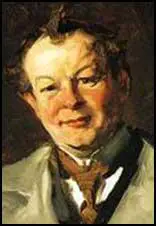George Luks

George Luks was born in 1867. After travelling in Europe he returned to the United States in 1894 and became an illustrator on The Philadelphia Press.
In 1896 Luks moved to New York where he became friends with Robert Henri and John Sloan . He was later associated with what Art Young described as the Ash Can School. Henri, who taught at the New York School of Art, was the leader of the group, and argued that art should be "a social force that creates a stir in the world". Henri also urged artists to use the "rich subject-matter provided by modern urban life".
When the National Academy in 1907 failed to recognize the importance of Robert Henri and his followers he mounted his own exhibition under the title, The Eight. Henri argued: "The revolutionary parties that break away from old institutions, from dead organizations are always headed by men with a vision of order, with men who realize that there must be a balance in life, so much of what is good for each man, so much to test the sinews of his soul, so much to stimulate his joy."
In 1913 the ideas of Henri inspired the International Exhibition of Modern Art (the Armory Show) held in New York City. The works of Luks appeared in the exhibition. Held at the 69th Regiment Armory, the exhibition included over 1,300 works, including 430 from Europe. The exhibition, held between 17th February and 15th March, received around 250,000 visitors.
Like Robert Henri and John Sloan, Luks identified himself with the poorer classes and the subject matter of his paintings often reflected his attempts to reflect contemporary issues. His best known painting is The Wrestlers. Luks continued to teach at the Arts Students League
George Luks, who was a heavy drinker, was found dead in a doorway in October 1933, after being involved in a drunken brawl.
Primary Sources
(1) Stuart Davis on the teaching of Robert Henri.
He would talk about the paintings we brought in for three of four hours, and in the process of talking about those pictures he would criticize them not from the standpoint of some pre-established norm of excellence, but in relation to his own ideas. He'd talk about his own interests while he was talking about the painting and in the way, since he had more experience, more purposeful experience with culture in general than the crew of youths who were there, his discussions were very educational affairs.
(2) Robert Henri, My People, The Craftsman: Volume 27 (February, 1917)
It is disorder in the mind of man that produces chaos of the kind that brings about such a war as we are today overwhelmed with. it is the failure to see the various phases of life in their ultimate relation that brings about militarism, slavery, the longing of one nation to conquer another, the willingness to destroy for selfish, inhuman purposes.
The revolutionary parties that break away from old institutions, from dead organizations are always headed by men with a vision of order, with men who realize that there must be a balance in life, so much of what is good for each man, so much to test the sinews of his soul, so much to stimulate his joy.
